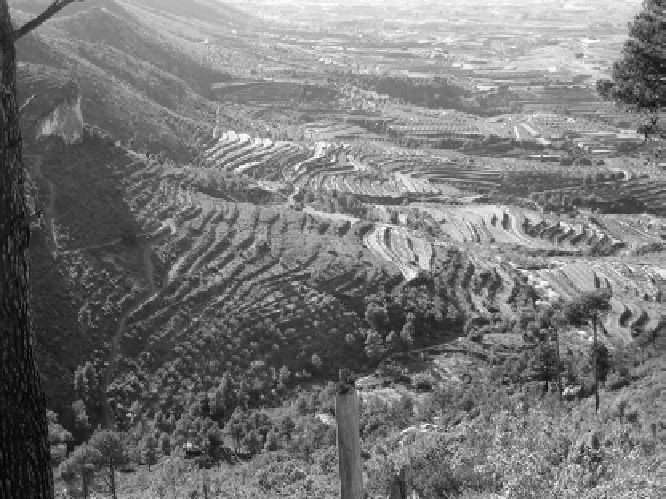Agriculture Reference
In-Depth Information
Fig. 4.2
Terraced slopes are a dominant feature of the landscapes in the Mediterranean Basin
and illustrate the strong human pressure in the region and the current old-field dynamics. Note
that fields are in use at the bottom, and are abandoned (and recolonized by shrubs) at the mid
and top portions of the slope (Vall d'Albaida, Valencia, Spain). (Photo by Juli Pausas.)
climatic changes. Similarly, it is difficult to distinguish between the anthropogenic
fire contribution and the natural (lightning) source in the Holocene fire regime
changes (Gil-Romera
et al.
2010
; Turner
et al.
2010
). It is often assumed that
although climate change drove vegetation change until
10 000 BP, human
activities (e.g. agriculture, forest clearing) have since become the determinant
factor influencing vegetation changes, beginning in the east and moving west
(Que´ zel & Me´ dail
2003
; Kaniewski
et al.
2008
). Grove & Rackham (
2001
) argued,
however, that many of the current open landscapes are not the product of human
activities but rather are driven by climatic factors. How these landscapes might
have looked with no human impact is very difficult if not impossible to know
because both climate-driven and human-driven changes have occurred simultan-
eously, and no natural reference landscape exists in the contemporary climate.
What is clear is that ancient descriptions of many landscapes bear little relation-
ship to current landscapes and such comparisons suggest intense land use and
deforestation over the past few millenia (Blondel & Aronson
1999
). Parallel to
anthropogenic and climatic changes there have been changes in the fire regime,
although the pattern of changes may vary through the basin. For instance, the
period with lower fire activity since the Last Glacial Maximum 18 kyr ago
coincided with the most arid period in dry areas, perhaps due to fuel limitations

